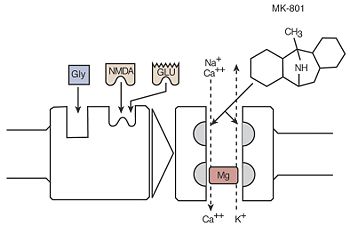N-methyl-d-aspartate receptor: Difference between revisions
Jump to navigation
Jump to search


imported>Richard Pettitt No edit summary |
imported>David E. Volk m (typo) |
||
| Line 3: | Line 3: | ||
[[Image:NMDA receptor.jpg|right|thumb|350px|{{#ifexist:Template:NMDA receptor.jpg/credit|{{NMDA receptor.jpg/credit}}<br/>|}}Activation occurs when either glutamate (Glu) or N-methyl-d-aspartate (NMDA) and glycine (Gly) bind to the receptor molecule. A channel within the receptor complex enables molecules to cross the cell membrane. Magnesium (Mg) blocks this channel. When Mg is removed from the channel and the receptor is activated, calcium (Ca<sup>2+</sup>) and sodium (Na<sup>+</sup>) ions enter the cell and potassium ions (K<sup>+</sup>) leave. MK-801 prevents the flow of ions across the membrane by binding to a site within the ion channel, thereby blocking NMDA receptor function and protecting the cell against excess activation (i.e., excitotoxicity).]] | [[Image:NMDA receptor.jpg|right|thumb|350px|{{#ifexist:Template:NMDA receptor.jpg/credit|{{NMDA receptor.jpg/credit}}<br/>|}}Activation occurs when either glutamate (Glu) or N-methyl-d-aspartate (NMDA) and glycine (Gly) bind to the receptor molecule. A channel within the receptor complex enables molecules to cross the cell membrane. Magnesium (Mg) blocks this channel. When Mg is removed from the channel and the receptor is activated, calcium (Ca<sup>2+</sup>) and sodium (Na<sup>+</sup>) ions enter the cell and potassium ions (K<sup>+</sup>) leave. MK-801 prevents the flow of ions across the membrane by binding to a site within the ion channel, thereby blocking NMDA receptor function and protecting the cell against excess activation (i.e., excitotoxicity).]] | ||
The '''N-methyl-d-aspartate receptor''' (NMDA receptor) is the binding site for [[glutamate]], [[n-methyl-d-aspartate]] and [[glycine]]. NMDA receptors are [[ionotropic]] as they allow calcium and sodium ions to flow into the cell while potassium ions leave. This excitatory change | The '''N-methyl-d-aspartate receptor''' (NMDA receptor) is the binding site for [[glutamate]], [[n-methyl-d-aspartate]] and [[glycine]]. NMDA receptors are [[ionotropic]] as they allow calcium and sodium ions to flow into the cell while potassium ions leave. This excitatory change hypopolarizes the cell and makes it more likely to [[action potential|fire]]. | ||
NMDA receptors are implicated in memory and learning through the process of [[long-term potentiation]]. | NMDA receptors are implicated in memory and learning through the process of [[long-term potentiation]]. | ||
Revision as of 17:13, 28 December 2007

(PD) Image: National Institute on Alcohol Abuse and Alcoholism
Activation occurs when either glutamate (Glu) or N-methyl-d-aspartate (NMDA) and glycine (Gly) bind to the receptor molecule. A channel within the receptor complex enables molecules to cross the cell membrane. Magnesium (Mg) blocks this channel. When Mg is removed from the channel and the receptor is activated, calcium (Ca2+) and sodium (Na+) ions enter the cell and potassium ions (K+) leave. MK-801 prevents the flow of ions across the membrane by binding to a site within the ion channel, thereby blocking NMDA receptor function and protecting the cell against excess activation (i.e., excitotoxicity).
Activation occurs when either glutamate (Glu) or N-methyl-d-aspartate (NMDA) and glycine (Gly) bind to the receptor molecule. A channel within the receptor complex enables molecules to cross the cell membrane. Magnesium (Mg) blocks this channel. When Mg is removed from the channel and the receptor is activated, calcium (Ca2+) and sodium (Na+) ions enter the cell and potassium ions (K+) leave. MK-801 prevents the flow of ions across the membrane by binding to a site within the ion channel, thereby blocking NMDA receptor function and protecting the cell against excess activation (i.e., excitotoxicity).
The N-methyl-d-aspartate receptor (NMDA receptor) is the binding site for glutamate, n-methyl-d-aspartate and glycine. NMDA receptors are ionotropic as they allow calcium and sodium ions to flow into the cell while potassium ions leave. This excitatory change hypopolarizes the cell and makes it more likely to fire.
NMDA receptors are implicated in memory and learning through the process of long-term potentiation.